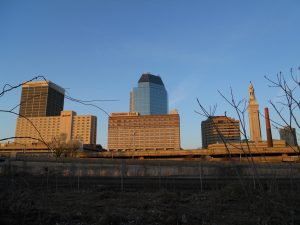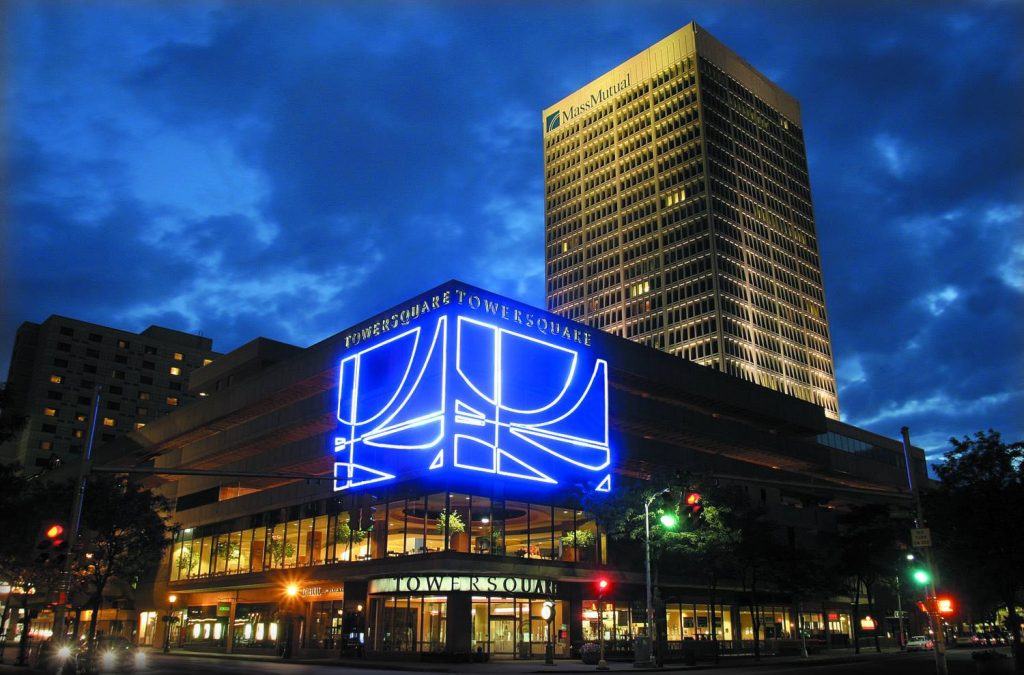Analysis: Wall Street Considers Main Street in Springfield…
UPDATED 8/17/17 8:25PM: For a Correction. The top photo originally misidentified 1211 Avenue of the Americas.
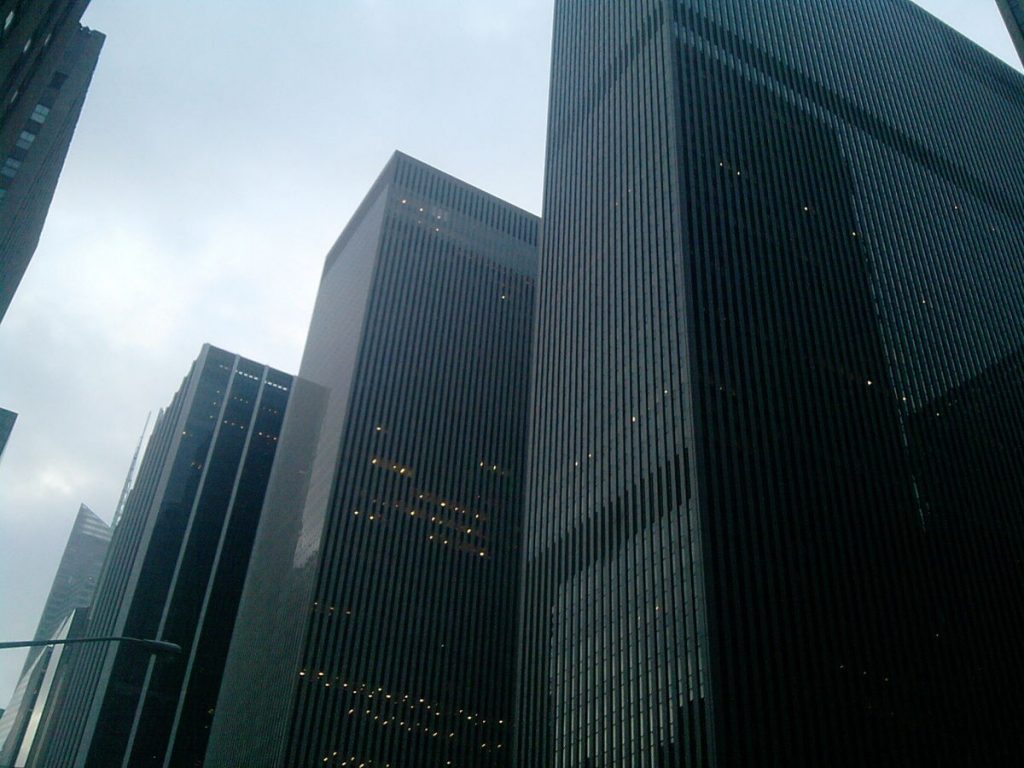
“We see you!” 1211 Avenue of the Americas, second from right, is home of The Wall Street Journal and other Murdoch Properties. (via wikipedia)
Not much links MGM Springfield’s construction site with 1211 Avenue of the Americas in New York. The former is feted as evidence of “momentum” in Springfield, like many a big project before it. The latter, home to The Wall Street Journal, is one of triplet towers near Rockefeller Center in Midtown’s skyscraper forest. But that distance did not stop The Journal from seeing clearly into Springfield’s situation.
The Journal’s visit to Springfield, however, did not come by way of Gotham. Rather, the paper’s Boston correspondent wrote the story. This was ironic as Springfield has poorer transit connection to its capital than New York. In fact, a key point in The Journal’s story was Springfield’s tepid economic recovery and relative isolation from major metropolises.
The malaise afflicting Springfield is not unique. The Journal compared the city’s situation to other Northeastern and Midwestern cities. In Ohio, for example, Cleveland and Cincinnati play the Boston to Canton or Dayton’s Springfield. But unlike those cities, the solution for Springfield—better transportation—is eminently doable. Politics is throwing up roadblocks.
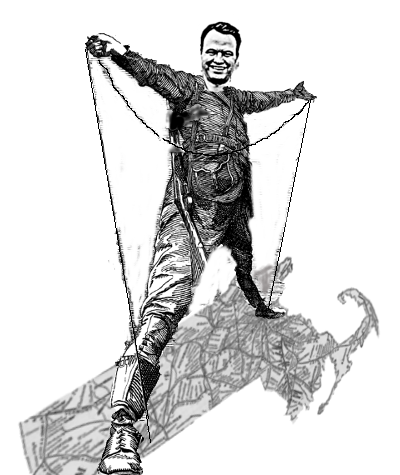
Lesser still trying to string together a commonwealth. (created via wikipedia & Lesser campaign images)
State Senator Eric Lesser, a Longmeadow Democrat, has attempted to start what would likely be a years-long effort to establish better rail service to Boston. Only one, slow train connects Beantown to Springfield now. But Lesser’s efforts has been repeatedly stymied by entrenched local interests and politicians, Beacon Hill’s Byzantine process, and a smiling but eastward-facing governor.
Ex-industrial cities like Springfield are under a microscope following last year’s election results. Nothing Donald Trump prescribed will revive such places, which swung heavily toward him, but that doesn’t change the need to do so. Indeed, Hampden County and Western Mass generally, followed Massachusetts’s rejection of Trump despite some deviation in the suburbs.
As important as The Journal’s manifest focus on connecting to Boston, another key point more subtly bolstered the paper’s case. The Journal effectively looked past MGM Springfield and the potentially more significant CRRC railcar plant. These were, rightly, not ignored. Yet, any reader unamiliar with Springfield could see current developments are woefully inadequate.
Sometimes it feels like city officials like Mayor Domenic Sarno present a Potemkin city. The spectacle of cranes, hovering over Springfield for the first time in years, fits nicely in a narrative of rebirth. Splashy Republican articles or television-ready milestones in MGM’s construction contribute to the case.
This narrative is not false, but it is not the whole truth. On its face, there is little reason to doubt MGM’s progress right now. The company’s candor at a recent Springfield City Council meeting was reassuring, especially compared to when it deleted its hotel skyscraper. However, issues not wholly within MGM’s control, like the spillover effect in downtown, draw question marks like moths to a flame.
One example is MassMutual putting Tower Square on the market. Despite idle speculation on WWLP and in The Republican or Business West, this does not inspire confidence. The life insurance giant’s divestment of real estate properties is not the concern. Its peers have been unloading real estate portfolios for decades. In a statement to WMassP&I, MassMutual suggested—somewhat dispassionately—“an increase in economic development” in downtown Springfield prompted the sale.
Rather, the concern is Marriott’s exit after decades downtown. A Marriott rep told WMassP&I in June the decision came after learning of MassMutual’s plans to sell the complex. Though the Marriott name has come down, the hospitality behemoth will run the hotel until December. Then what?
“In the event of a new hotel operator, the new operator will have the opportunity to inform the team about employment opportunities,” Marriott spokesperson Lucy Slosser told WMassP&I.
MassMutual seemed to nod in that direction when queried about what happens if there was no buyer by December 15, the day Marriott leaves town.
“We will be seeking a buyer for the hotel who would make decisions about the future operations of the hotel property,” Jim Lacey, MassMutual’s head of media relations said in a June email. “If a buyer is not secured by the end of Marriott’s contract…we have many options, including operating it under alternate models or brands.”
This seems somewhat open-ended and indefinite. It certainly does not signal faith in the city’s upper-end hotel market.
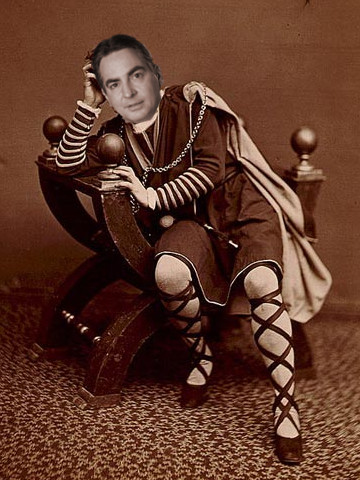
Mayor Sarno’s efforts to build Springfield’s economy have borne some fruit, but the scale of the problem remains massive. (image made via Springfield mayoral portrait & loc.gov files)
Economic development can also be overstated. Mayor Sarno often claims there is $3.3 billion in public and private investment going into Springfield, an inflated figure. This includes long-finished hospital expansions or hardly-discretionary I-91 repairs. Tens of millions of MGM’s cost have gone to financing, Boston lobbyists and state fees. In fairness, Chief Development Officer Kevin Kennedy has discussed revising the $3.3 billion figure down to exclude older projects. A more accurate number—$2 billion give or take a hundred million—would still be impressive.
Still, MGM skeptics cannot dismiss the casino’s potential even if Connecticut’s tribes successfully build their East Windsor gaming outpost. CRRC could yet spawn a new wave of manufacturers and machinists who perform work on top of the factory’s employees. Then there is Union Station. While still unfinished at track level, it could usher in the biggest bang for the buck among downtown’s projects.
But alone these are not enough. As The Journal observed, storefronts remain empty in downtown, across the city and in nearby towns. The region’s shopping centers are dying outside of the wealthiest suburbs. Poverty remains high and the infrastructure needs far outstrip available funding.
Springfield lands in the @WSJ and not for good reasons. https://t.co/oXJAMIfYMh Jobless rate is low but troubling signs remain.
— Jon Chesto (@jonchesto) August 9, 2017
Springfield Mass. has a refurbished, grand train station. But for now, Boston is far away via MassPike https://t.co/SbTNOZgdvN via @WSJ pic.twitter.com/XqNuaHDNqj
— Jon (@jon_kamp) August 9, 2017
In other words, Springfield and the 413 more broadly are not out of the woods.
These problems can seem small compared to the developments that grab the headlines, but they are pervasive and deep in Greater Springfield. This is the understated argument in The Journal’s piece.
There no silver bullets, not even rail. But regular service to Boston, a mere 90 miles away, seems the only solution capable of matching the scale of Springfield’s and the 413’s plight. If national publications can see it, so must the region and the commonwealth.
